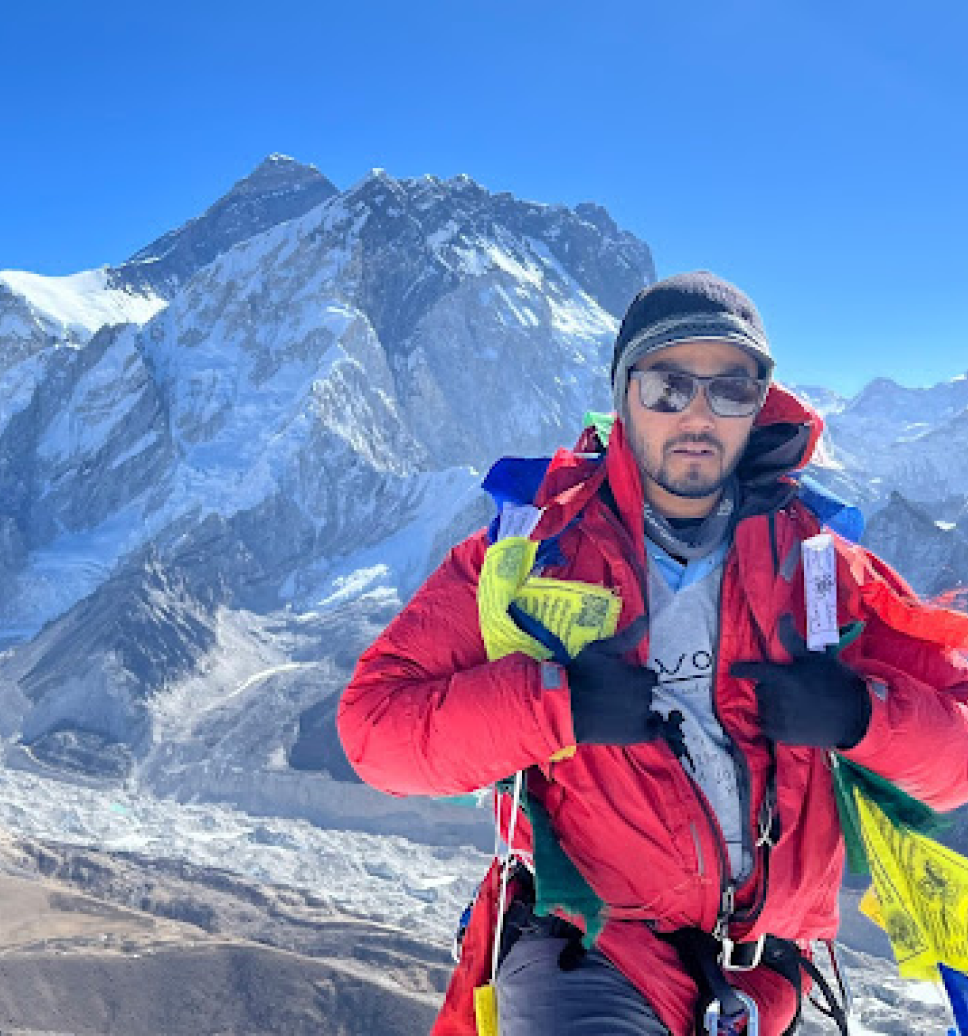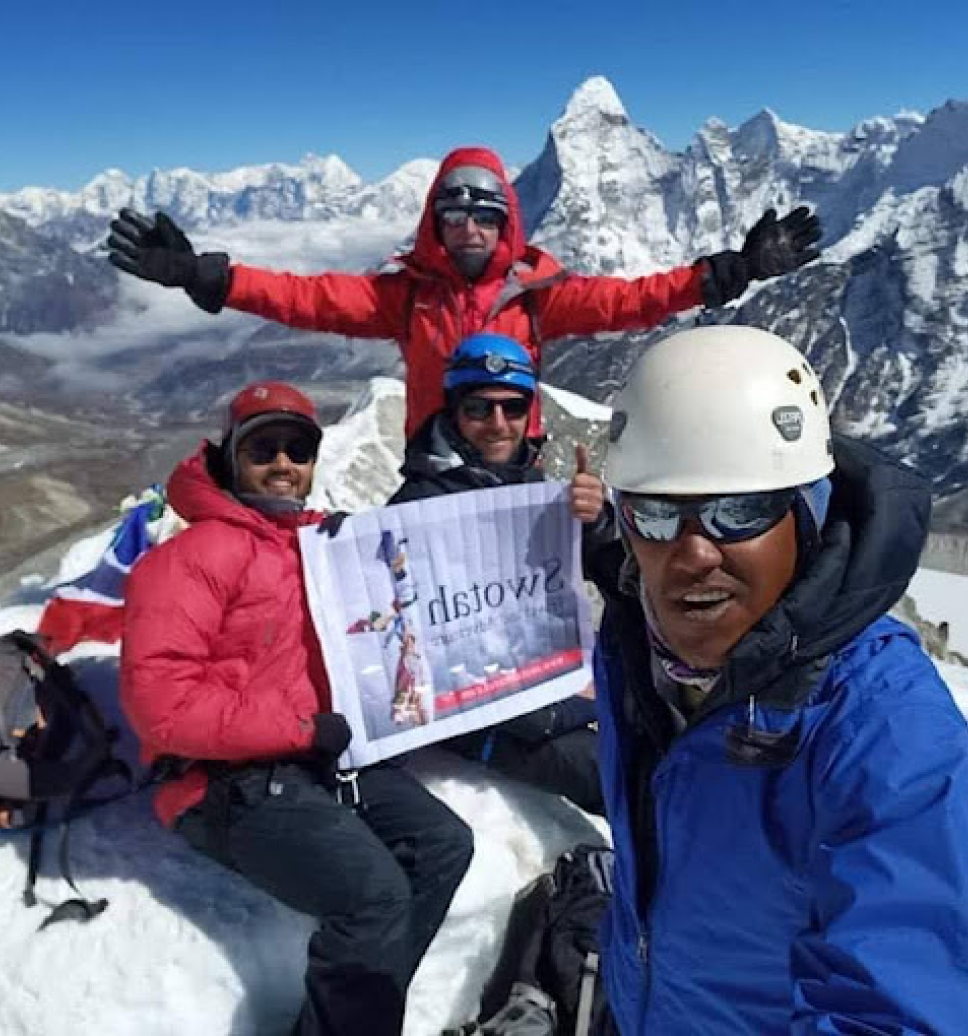GUARANTEED DEPARTURES
Check upcoming trip dates, availability & prices. If you can't see dates that suite you, contact us we will do our best to assist you.
| GUARANTEED DEPARTURES | PRICE | AVAILABILITY | |
| Mar 2, 2026 - Mar 31, 2026 | $2875 | High | |
| Mar 3, 2026 - Mar 31, 2026 | $2875 | High | |
| Apr 3, 2026 - May 2, 2026 | $2875 | High | |
| Apr 5, 2026 - May 3, 2026 | $2875 | High | |
| Sep 5, 2026 - Oct 3, 2026 | $2875 | High |
Trek Highlights
- Kanchenjunga is the third-highest mountain.
- It is called the Five Treasures of Snow after its five high peaks. The treasures represent the five repositories of God: gold, silver, gems, food grains, and religious texts.
- The area around Kangchenjunga is said to be home to the “Kangchenjunga Demon”, a type of yeti or rakshasa.
- Kanchenjunga lies nearly 125 kilometres (78 miles) east-southeast of Mount Everest.
- Kanchenjunga is the second least climbed mountain out of the 14 highest mountains in the world.
- Until 1852, Kanchenjunga was considered the highest mountain in the world.
- Kangchenjunga was first climbed on 25 May 1955 by Joe Brown and George Band, who were part of a British expedition.
- Spring and Autumn are the best seasons to visit Kanchenjunga.

This trek is an opportunity to reach the base camp of the world’s third tallest mountain on an off-the-beaten trail, perfect for trekkers who cherish nature and believe in its beauty.
Photo Gallery
Dive into our gallery to get a glimpse of the awe-inspiring vistas waiting for you on our guided treks across stunning landscapes.
Brief Itinerary
Day
1
ARRIVAL
Day
2
KATHMANDU SIGHTSEEING
Day
3
FLIGHT TO BHADRAPUR, DRIVE TO SUKETAR (2420M, 5HRS)
Day
4
TREK TO PHURUMBU (1542M, 4-5HRS)
Day
5
TREK TO CHIRUWA (1270M, 5-6HRS)
Day
6
TREK TO SUKETHUM (1585M, 6-7HRS)
Day
7
TREK TO AMJILOSA (2395M, 6HRS)
Day
8
TREK TO GYABLA (2730M, 6-7HRS)
Day
9
TREK TO GUNSA (3427M, 7-8HRS)
Day
10
TREK TO KAMBACHEN (4050M, 6-7HRS)
Day
11
TREK TO LHONAK (4780M, 6-7HRS)
Day
12
TREK TO KANCHENJUNGA BASE CAMP (5143M, 5-6HRS)
Day
13
TREK TO KAMBACHEN (4050M, 8-9HRS)
Day
14
TREK TO GUNSA (3427M, 4-5HRS)
Day
15
TREK TO TANBHARMA DANDA (4641M, 6-7HRS)
Day
16
TREK TO CHERAM (3870M, 7-8HRS)
Day
17
TREK TO RAMCHAUR (4580m, 3-4HRS)
Day
18
REST DAY
Day
19
TREK TO YALUNG BASE CAMP (4500M, 4-5HRS), TREK BACK TO RAMCHAUR (3HRS)
Day
20
TREK TO TORONG (2995M, 5-6HRS)
Day
21
TREK TO LASIYA BHANJYANG (3310M, 6HRS)
Day
22
TREK TO YAMPHUDIN (2080M, 5HRS)
Day
23
TREK TO PHUMPHE DANDA (1858M, 7-8HRS)
Day
24
TREK TO KANDE BHANJYANG (2129M, 6-7HRS)
Day
25
TREK TO LALIKHARKA (2265M, 7-8HRS)
Day
26
TREK TO SUKETAR (2420M, 6HRS)
Day
27
DRIVE TO BHADRAPUR (5hrs)
Day
28
FLY TO KATHMANDU
Day
29
DEPARTURE
Comprehensive Trek Guide
The Kanchenjunga Base Camp Trek is an exhilarating and adventurous journey through the remote eastern region of Nepal, offering a diverse array of flora and fauna. The sacred Mt. Kanchenjunga, along with other stunning peaks such as Mt. Kumbhakarna, Mt. Kiratchuli, Mt. Nepal Peak, Pathibhara Himal, and Chang Himal, make up the breathtaking landscape that trekkers can explore. Locals revere and worship Mt. Kanchenjunga, and as a sign of respect, no one attempts to climb its actual summit.
Opened for trekking since 1998, the Kanchenjunga base camp trek is the longest in Nepal. It is completed in 30 days and is filled with an adrenaline rush, panoramic views, the Yalung glacier, a beautiful cardamom farm, exotic wildlife, and exposure to the remote lifestyle of the locals and their cultural and traditional values.
Straddling the border between India and Nepal, the Kanchenjunga massif boasts seven major snow-capped summits, captivating vistas, and untamed natural vegetation. As the third-highest mountain in the world, reaching 8,400 meters (27,559.06 feet), it is unsurprising that the Kanchenjunga Base Camp Trek ascends to a considerable elevation. Consequently, the risk of altitude sickness and respiratory issues is heightened, so trekkers should consult their doctor and adhere to the necessary precautions to ensure a safe and enjoyable experience.
Where is Kanchenjunga?
Kanchenjunga, the world's third-highest mountain, is located in the eastern region of the Himalayas on the border between Nepal and India. At an elevation of 8,586 meters (28,169 feet), it is surpassed in height only by Mount Everest and K2. The mountain is comprised of five individual peaks, with the main peak being Kanchenjunga Main.
The name "Kanchenjunga" translates to "Five Treasures of the Snow," which refers to the five peaks that make up the mountain massif. These peaks are believed to represent the five repositories of God – gold, silver, gems, grain, and holy books.
Kanchenjunga straddles the border between the easternmost part of Nepal and the Indian state of Sikkim. The mountain is nestled within the Kanchenjunga Conservation Area in Nepal and the Khangchendzonga National Park in India, both of which are dedicated to preserving the region's unique biodiversity and cultural heritage.
The Kanchenjunga massif is a revered site for both the local communities and climbers from around the world. The mountain holds great religious significance for the people living in the region, who consider it a sacred abode.
The Kanchenjunga region remains relatively remote and less frequented compared to other trekking areas in Nepal, such as the Everest and Annapurna regions. This allows trekkers to immerse themselves in the area's pristine wilderness and experience the vibrant local cultures in a more serene and authentic setting.
Why Kanchenjunga Trek?
The Kanchenjunga Base Camp Trek is a popular trekking route in Nepal, known for its stunning mountain views, pristine natural beauty, and unique cultural experiences. Here are some reasons why people choose to do the Kanchenjunga Trek:
Spectacular mountain views: The Kanchenjunga region is home to some of the world's highest peaks, including Kanchenjunga (8,586m), the third-highest mountain in the world. The trek offers breathtaking views of these majestic peaks, as well as other peaks like Jannu (7,710m), Yalung Kang (8,505m), and Kabru (7,353m).
Cultural experiences: The trek takes you through remote villages and settlements of the indigenous Limbu people, who have a unique culture and way of life. You can experience their hospitality, taste their local cuisine, and learn about their customs and traditions.
Pristine natural beauty: The Kanchenjunga region is one of the most untouched and unspoiled regions in Nepal, with vast stretches of forests, alpine meadows, and glacial rivers. The trek offers a chance to immerse yourself in this pristine natural environment and experience its beauty up close.
Challenging trekking: The Kanchenjunga Trek is a challenging trek that takes you through rugged mountain terrain, high-altitude passes, and steep ascents and descents. It's a great trek for experienced trekkers looking for a challenge and adventure.
Off the beaten path: Compared to other popular trekking routes in Nepal, like the Everest Base Camp and Annapurna Circuit, the Kanchenjunga Trek is relatively less crowded. You can enjoy the solitude and tranquillity of the mountains without the crowds of other trekkers.
Best Time for Kanchenjunga Base Camp Trek
The best time for the Kanchenjunga Base Camp Trek is during the pre-monsoon and post-monsoon seasons, which typically fall between March to May and September to November. Each season offers unique experiences and conditions that cater to different preferences.
Spring (March to May): Spring is a popular time for the Kanchenjunga Base Camp Trek, as the weather is relatively stable and temperatures are moderate. Daytime temperatures range from 10-20°C (50-68°F), while nighttime temperatures can drop to 0-5°C (32-41°F). The landscapes are lush and colourful, with rhododendrons and other wildflowers in full bloom. Wildlife is active during this period, offering excellent opportunities for spotting various species of birds and animals. The trails are less crowded compared to the autumn season, allowing for a more peaceful trekking experience.
Summer/Monsoon (June to August): Trekking during the monsoon season is not recommended due to heavy rainfall, which can cause landslides, muddy trails, and poor visibility. The humidity levels are high, and leeches are abundant in lower altitudes. However, if you are an experienced trekker seeking a challenge and a truly off-the-beaten-path experience, you might find the monsoon season appealing. Expect limited mountain views but lush green landscapes and fewer trekkers on the trails.
Autumn (September to November): Autumn is considered the best time for the Kanchenjunga Base Camp Trek, as the weather is stable with clear skies and unobstructed views of the mountain peaks. Daytime temperatures range from 10-20°C (50-68°F), while nighttime temperatures can drop to -5 to 5°C (23-41°F). The monsoon rains clear the dust and pollution, offering crystal-clear panoramas of the Himalayas. This season is also ideal for witnessing the vibrant cultural festivals of Dashain and Tihar. Be prepared for busier trails, as this is the peak trekking season in Nepal.
Winter (December to February): Winter is the least popular season for trekking in the Kanchenjunga region due to cold temperatures, heavy snowfall, and the risk of avalanches. Daytime temperatures can range from 0-5°C (32-41°F), while nighttime temperatures can plummet to -20°C (-4°F) or lower at higher altitudes. However, for well-prepared and experienced trekkers, the winter season offers a unique and challenging adventure with pristine snow-covered landscapes, fewer trekkers on the trails, and clear skies on the days when the weather is stable.
In summary, the best time for the Kanchenjunga Base Camp Trek depends on your preferences and priorities. For optimal weather and mountain views, consider trekking during autumn, while spring offers a more tranquil experience with blooming rhododendrons and active wildlife.
Accommodation during the Kanchenjunga Trek
During the Kanchenjunga Base Camp Trek, accommodation options are primarily in the form of teahouses and lodges, which provide basic facilities and a comfortable resting place after a day of trekking. Here's a detailed overview of what to expect from the accommodations:
- Teahouses: Teahouses are small, family-run establishments that offer basic lodging and meals to trekkers. They are an integral part of trekking in Nepal and provide a warm, hospitable environment where you can interact with fellow trekkers and locals.
- Bathrooms: Lower-altitude teahouses typically have shared bathrooms with Western-style toilets and running water. As you ascend to higher altitudes, the facilities may become more basic, with squat toilets and no running water. Hot showers are usually available at an additional cost, but they might be limited at higher elevations.
- Rooms: Teahouse rooms are simple and clean, usually featuring twin beds with a mattress, pillow, and blanket. It's advisable to bring your own sleeping bag for added comfort and warmth. Depending on the teahouse's location and altitude, the rooms may or may not have an attached bathroom.
- Dining: Meals are served in a common dining area, which is typically heated by a wood or yak dung stove. Teahouses offer a selection of local and international dishes, including Nepali, Indian, Tibetan, and Western cuisine. Staple foods like rice, pasta, and potatoes are widely available, while fresh vegetables and fruits are more limited as you ascend in altitude. It's important to stay hydrated during the trek, and you can purchase bottled water, boiled water, or water purification tablets at teahouses.
- Lodges: In some villages along the Kanchenjunga Base Camp Trek, you may come across lodges similar to teahouses but may offer slightly better facilities and more comfortable accommodations.
- Dining: Lodges offer a wider variety of food options compared to teahouses, with more extensive menus and better quality ingredients. The dining area in lodges is usually more spacious and comfortable, providing a pleasant atmosphere for meals and relaxation.
- Bathrooms: Lodges often have shared or private bathrooms with Western-style toilets and running water. Hot showers are more likely to be available at lodges compared to teahouses, although they may still come at an additional cost.
- Rooms: Lodge rooms are generally more spacious and comfortable than teahouse rooms, with better mattresses and bedding. Depending on their location, some lodges may also provide private rooms with attached bathrooms.
It's important to note that accommodation options during the Kanchenjunga Base Camp Trek are basic, especially at higher altitudes. Adjusting your expectations and being prepared with essential items like a sleeping bag, warm clothing, and personal hygiene supplies will help ensure a more enjoyable and comfortable trekking experience.
Packing List for Kanchenjunga Base Camp Trek
A well-prepared packing list is crucial for a successful and enjoyable Kanchenjunga Base Camp Trek. The following items are recommended to ensure your comfort, safety, and convenience during the trek:
Clothing
Base layers: Moisture-wicking, quick-drying base layers (tops and bottoms) made of synthetic or merino wool material to keep you warm and dry.
Mid-layers: Insulating mid-layers like fleece jackets or lightweight down jackets for added warmth during colder temperatures.
Outer layers: Wear waterproof and breathable shell jackets and pants to protect yourself from wind, rain, and snow.
Trekking shirts and pants: Quick-drying, breathable, and comfortable trekking shirts (long and short-sleeved) and pants.
Undergarments: Synthetic or merino wool underwear and sports bras for maximum comfort and moisture management.
Footwear: Sturdy, waterproof, and well-fitted trekking boots with good ankle support, along with comfortable, moisture-wicking trekking socks.
Gloves: Lightweight and insulating gloves for varying temperatures and waterproof gloves or glove liners for colder conditions.
Hats: Wear a wide-brimmed sun hat for protection against the sun and a warm beanie or fleece hat for cold temperatures.
Neck gaiter or buff: Versatile accessory for protecting your neck and face from the sun, wind, and cold.
Sleepwear: Warm, comfortable sleepwear for nights in teahouses and lodges.
Equipment
Backpack: 40-60 litre backpack with a rain cover, comfortable shoulder straps, and a hip belt to distribute weight evenly.
Trekking poles: Adjustable trekking poles for added stability and support during the trek.
Sleeping bag: Good-quality, four-season sleeping bag with a comfort rating of -10°C to -20°C (14°F to -4°F), depending on personal preference.
Headlamp: Lightweight, durable headlamp with extra batteries for early morning starts or late-night arrivals.
Water bottles or hydration bladders: If using water bottles, they should have at least 2 litres of water-carrying capacity and insulated covers.
Water purification tablets or filters: These are used to treat drinking water along the trek.
Dry bags or plastic bags: To keep your belongings dry and organized inside your backpack.
Sunglasses: High-quality, UV-protective sunglasses for protection against strong sunlight and glare.
Trekking towel: Quick-drying, lightweight, and compact towel for personal hygiene.
Camera or smartphone: For capturing memories and breathtaking landscapes.
Personal items
Sunscreen: High-SPF, broad-spectrum sunscreen to protect your skin from harmful UV rays.
Lip balm: Lip balm with SPF to prevent chapped lips.
Toiletries: Toothbrush, toothpaste, soap, shampoo, deodorant, toilet paper, and any other personal hygiene items.
First aid kit: Basic first aid supplies, such as adhesive bandages, pain relievers, altitude sickness medication, anti-diarrhea medication, and any personal prescription medications.
Snacks: Energy bars, trail mix, and other lightweight, high-energy snacks to keep you fueled throughout the trek.
Hand sanitiser and wet wipes: These are used to maintain hygiene when handwashing facilities are limited.
Cash: Small denominations of Nepalese rupees for tips, snacks, and other miscellaneous expenses along the trek.
Documents: Passport, trekking permits, travel insurance, and any other necessary identification or documentation.
Entertainment: Books, playing cards, or other lightweight entertainment options for downtime in teahouses and lodges.
Map and compass: To navigate the trail in case of emergencies or if you get lost.
Portable water filter: To avoid the use of plastic bottles and help the environment.
Permits Kanchenjunga Base Camp Trek
To trek to the Kanchenjunga Base Camp, you need to obtain two permits: the Restricted Area Permit (RAP) and the Kanchenjunga Conservation Area Permit (KCAP).
The Restricted Area Permit is required because the trek passes through a restricted area close to the border of India and China. The Nepalese government issues the permit, which you need to apply for through a registered trekking agency. The permit fee for the first four weeks is USD 10 per person per week, and for the additional weeks, it is USD 20 per person per week.
The Kanchenjunga Conservation Area Permit is required to enter the Kanchenjunga Conservation Area. The permit is issued by the Conservation Area Management Committee (CAMC) and can be obtained from the CAMC office in Suketar, Taplejung or Kathmandu. The permit fee for foreigners is NPR 2,000 (approximately USD 20) per person per week.
In addition to the permits, you also need to obtain a Trekkers' Information Management System (TIMS) card. The TIMS card is issued by the Trekking Agencies Association of Nepal (TAAN) and is required for all trekkers in Nepal. The card can be obtained from the TAAN office in Kathmandu or Pokhara, or the TIMS counter in the Nepal Tourism Board office in Kathmandu. The fee for the TIMS card is USD 20 per person.
It's important to note that you cannot obtain the TIMS, RAP, and KCAP permits independently. You must go through a registered trekking agency to obtain the permits, and you also need to be accompanied by a licensed trekking guide.
Kanchenjunga Base Camp Trek Difficulty Level
The Kanchenjunga Base Camp Trek is considered challenging and is suitable for experienced trekkers who are physically fit and have some prior trekking experience. The trek involves steep ascents and descents, high-altitude passes, and rugged mountain terrain, which can be physically demanding.
The trek takes about 20 to 30 days to complete, depending on the route and itinerary, and covers a distance of approximately 200 km (125 miles). The maximum elevation on the trek is at Pangpema (Kanchenjunga North Base Camp) at 5,140 meters (16,870 feet).
One of the biggest challenges on the Kanchenjunga Trek is the high altitude, which can lead to altitude sickness. To prevent altitude sickness, trekkers need to acclimatize properly and ascend slowly.
The trek also involves crossing several high-altitude passes, including Sele La (4,290 meters/14,074 feet), Sinion La (4,660 meters/15,288 feet), and Mirgin La (4,480 meters/14,698 feet). These passes can be challenging due to their steep inclines, loose gravel, and narrow paths.
The weather conditions on the trek can also be challenging, with temperatures dropping to below freezing at night and in the early morning. Trekkers need to be prepared for cold temperatures and carry appropriate clothing and gear.
Overall, the Kanchenjunga Base Camp Trek is a challenging trek that requires physical fitness, prior trekking experience, and proper preparation. However, the stunning mountain views, pristine natural beauty, and unique cultural experiences make it a rewarding and unforgettable trekking experience.
Tipping Recommendation
We recommend allocating 10-15% of your total tour cost to tipping guides, drivers, and other hardworking staff who ensure your experience is unforgettable. While tipping is not mandatory, it is a meaningful way to support the seasonal workers who dedicate themselves to making your trip extraordinary.
By booking with us and participating in the tipping culture, you are directly contributing to Nepal’s local economy and helping sustain the tourism workforce. This support is crucial in retaining talent within the country and addressing challenges like brain drain.
Your generosity makes a lasting impact—thank you!
Detailed Itinerary
Meals: Dinner
Accommodation: Hotel
Meals: Breakfast
Accommodation: Hotel
Meals: Breakfast,Lunch,Dinner
Accommodation: Guesthouse
Meals: Breakfast,Lunch,Dinner
Accommodation: Teahouse
Meals: Breakfast,Lunch,Dinner
Accommodation: Teahouse
Meals: Breakfast,Lunch,Dinner
Accommodation: Teahouse
Meals: Breakafst,Lunch,Dinner
Accommodation: Teahouse
Meals: Breakfast,Lunch,Dinner
Accommodation: Teahouse
Meals: Breakfast,Lunch,Dinner
Accommodation: Teahouse
Meals: Breakfast,Lunch,Dinner
Accommodation: Teahouse
Meals: Breakfast,Lunch,Dinner
Accommodation: Teahouse
Meals: Breakfast,Lunch,Dinner
Accommodation: Teahouse
Meals: Breakfast,Lunch,Dinner
Accommodation: Teahouse
Meals: Breakfast,Lunch,Dinner
Accommodation: Teahouse
Meals: Breakfast,Lunch,Dinner
Accommodation: Teahouse
Meals: Breakfast,Lunch,Dinner
Accommodation: Teahouse
Meals: Breakfast,Lunch,Dinner
Accommodation: Teahouse
Meals: Breakfast,lunch,Dinner
Accommodation: Teahouse
Meals: Breakfast,Lunch,Dinner
Accommodation: Teahouse
Meals: Breakfast,Lunch,Dinner
Accommodation: Teahouse
Meals: Breakfast,Lunch,Dinner
Accommodation: Teahouse
Meals: Breakfast,Lunch,Dinner
Accommodation: Teahouse
Meals: Breakfast,Lunch,Dinner
Accommodation: Teahouse
Meals: Breakfast,Lunch,Dinner
Accommodation: Teahouse
Meals: Breakfast,Lunch,Dinner
Accommodation: Teahouse
Meals: Breakfast,Lunch,Dinner
Accommodation: Guesthouse
Meals: Breakfast,Lunch,Dinner
Accommodation: Guesthouse
Meals: Breakfast
Accommodation: Hotel
Meals: Breakfast
Accommodation:
What's Included
- Airport transfers;
- Standard/Deluxe room in Kathmandu on twin/double sharing with breakfast;
- Guided sightseeing tour in Kathmandu on a private vehicle;
- Accommodation during the trek (or camping in case of need);
- All meals (breakfast, lunch, dinner with one drink along) during the trek;
- Authorized English-speaking guide along with porters (2:1);
- All applicable government tax;
- All expenses for all staff: meals, accommodation, salary, equipment, insurance, transportation;
- All necessary paperwork and Kanchenjunga Special Trekking Permit, Trekkers' Information Management System fees (TIMS);
- Medical kit;
What's not Included
- International flights, Nepalese visa fee;
- Excess baggage charge(s) for the domestic flight;
- Extra night accommodation in Kathmandu and Pokhara because of early arrival, late departure, or early return from the mountain due to any reason other than the scheduled itinerary;
- Lunch and evening meals in Kathmandu;
- Entrance fees during sightseeing;
- Travel and rescue insurance;
- Personal expenses (phone calls, laundry, bar bills, battery recharge, extra porters, bottle or boiled water, shower, etc.);
- Tips for guide(s), porter(s) and driver(s).
Frequently Asked Question
1. Will somebody come to pick me up at the airport upon arrival
2. Is there an Orientation program
3. What is the overnight accommodation like
4. How big are the groups
5. Is Travelling in Kanchenjunga Base Camp safe for women
6. What about security during trekking
7. What sort of food can I expect in trekking
8. Is the drinking water safe in trekking region
9. What mode of transportation do you use
10. What is the best season for trekking in Kanchenjunga Base Camp
11. Will I be taken care of during emergency
12. What is appropriate dress for trekking
13. Is it possible to alternate or change the day trips
14. Are we sure to get room while trekking
15. Are your guides reliable and certified
16. How can I charge my electronics during the trip
17. Is there any communication while we are on trekking
18. Can I add extra days to my trekking trip
19. How many hours do I have to trek each day
20. How will my booking be processed
21. What immunizations will I need
22. Can we use the credit card during the trek
23. Do we need to carry our bags by our self or you will provide porters
Got a question about this tour?
Or looking for customize trip, reach out to our travel experts

.jpg)


















